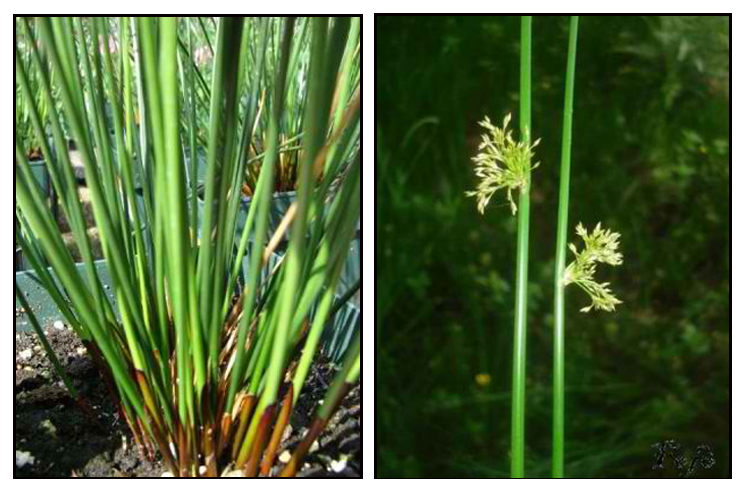 Gen info Gen info
- Juncus is a genus of monocotyledonous flowering plants, commonly known as rushes. It is the largest genus in the family Juncaceae, containing around 340 species.
- The genus Juncus was first named by Carl Linnaeus in his 1753 Species Plantarum. (25)
-
Etymology: The genus name Juncus derives from Latin jungere, meaning "to tie or bind'", referring to the stems of some species used for tying or making cord. The specific epithet effusus derives from a Latin word meaning "to spread out" or "sprawling", likely referring to its growth habit.
-
Commerce: In 1989 and 1990, the production of Juncus effusus stems in Japan was 90,000-100,000 t per year from an area of 8,400 ha. (30)
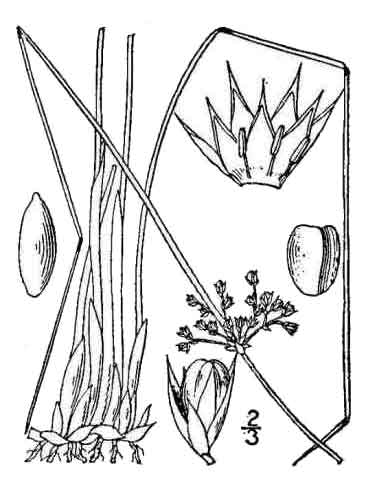 Botany Botany
• Piñgot is a plant that usually forms circular, dense, matted tufts of finely striate stems, 30 to 90 centimeters high, soft and pithy. Base of the stalk is surrounded by short, sheathing leaves. Inflorescence is very variable, lax and pendulous, with slender branches and distant flowers, or globose and sessile with densely packed flowers. Sepals are lanceolate, exceeding the length of the obovoid brownish capsules. Seeds are minute, yellow, and very obtuse at each end.
• Juncus effusus grows in large clumps up to about 1.2 meters (3 ft 11 in) tall.[4]: 984  The stems are smooth cylinders with light pith filling. The yellowish inflorescence appears to emerge from one side of the stem about 20 centimeters (8 in) from the top. In fact the stem ends there; the top part is the bract, that continues with only a slight colour-band marking it from the stem. The lower leaves are reduced to a brown sheath at the bottom of the stem.
Distribution
- Naturalized. (11)
-
Locally abundant. In open, swampy places at all altitudes from 1,400 to 3,000 meters in Luzon (Benguet, Bontoc Subprovinces).
- Native range is the temperate Northern Hemisphere to W. South America, Rwanda to S. Africa, W. Indian Ocean. A perennial and grows primarily in the temperate biome. (14)
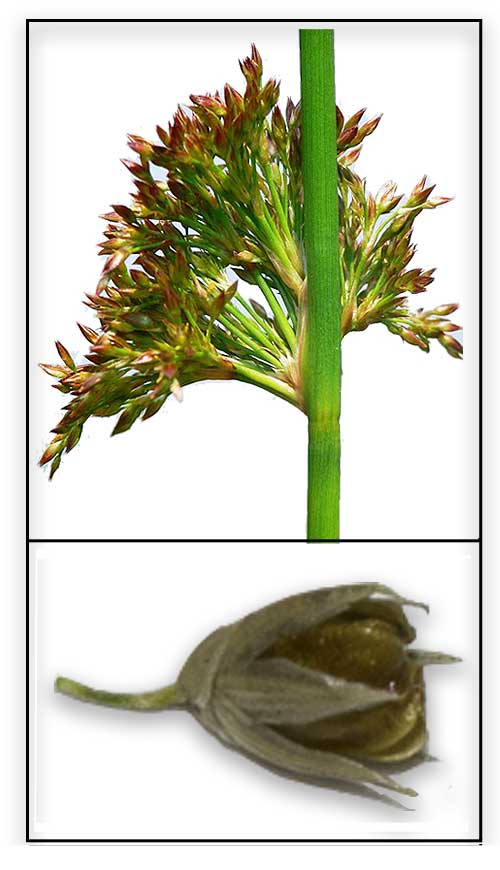 Constituents Constituents
- Stems yield araban and xylan.
-
Study isolated 13 compounds from the medullae - juncusyl ester A and B, 5-a spinasterol, B-sitosterol, effusol, p-coumaric acid, nobiletin, quercetin, rutinose, among others.
- Study isolated a new cycloartanelactone glucoside, Juncoside I.
- Dry stems yielded six phenolic constituents: 7-carboxy-2-hydroxy-1-methyl-5-vinyl-9, 10-dihydrophenanthrene, 2,3-isopylidene-1-O-ferulic acid glyceride, (2S)-2, 3-isopylidene-1-0-p-coumaroyl glyceride, dehydroeffusal, p-hydroxy
benzaldehyde and luteolin- 5,3'-dimethyl ether.
- Study isolated 30 compounds. Six compounds were named 7-carboxy-2-hydroxy-1-methyl-5-vinyl-9, 10-dihydrophenanthrene (1), 2,7-dihydroxy-1-methyl-pyrene (2), 7-hydroxy-2-methoxy-1-methyl-pyrene (5), 2,7-dihydroxy-5-hydroxymethyl-1-methyl-phenanthrene (7), effusenone A (10), 2,3-isopropylidene-1-O-ferulic acid glyceride. The other 15 known compounds were identified as: dehydroeffusal (3), 2,7-dihydroxy-1, 6-dimethyl-pyrene (5), dehydroeffusol (6), juncusol (8),2,7-dihydroxy-1-methyl-5-vinyl-9,10-dihydrophenanthrene (9),β-sitosterol (11), 3β-hydroxy-5α,8α-epidiocyergosta-6E,22E-diene (12), 7-oxo-β-sitosterol (13), stigmast-4-en-6β-ol-3-one (14), (24R)-stigmast-4-ene-3-one (15), daucosterol (16), (2S)-2,3-isopropylidene-1-O-p-coumaroyl glyceride (18), p-hydroxybenzaldehyde (19), 3-hydroxy-2,5-hexadione (20), luteolin-5,3′-dimethyl ether (21). (see study below) (17)
- Study of aerial parts yielded eight phenanthrene viz. 7-carboxy-2-hydroxy-1-methyl-5-vinyl-phenanthrene (1); 2,7-dihydroxy-1-methyl-5-aldehyde-9,10-dihydrophenanthrene (2); dehydroeffusol (3); dehydrojuncusol (4); 7-carboxy-2-hydroxy-1-methyl-5-vinyl-9,10-dihydrophenanthrene (5); 8-carboxy-2-hydroxy-1-methyl-5-vinyl-9,10-dihydrophenanthrene (6); effusol (7) and juncusol (8). (see study below) Â Â (20)
- Study isolated a new sesquilignan effususin E (1) and a new long chain fatty enamide effususin F (2), along with eight known compounds from the medullae of Juncus effusus. (see study below) (21)
- Bioactivity guided phytochemical investigation yielded seven new phenanthrenoids along with nine known compounds, including eight phenanthrenoids and a benzophenone from the dichlormethane soluble fraction of ME of medullae. (see study below) (23)
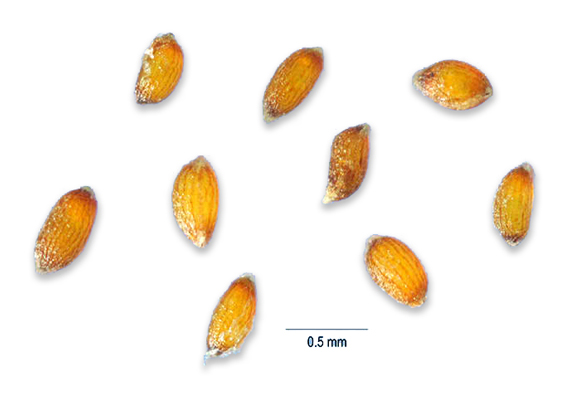 Properties Properties
- Traditionally considered antilithic, antiphlogistic, depurative, diuretic, descutient, febrifuge, pectoral and sedative.
- Seeds are cathartic.
- Studies have suggested sedative, anxiolytic, hypnotic, cytotoxic, anti-inflammatory, antibacterial, anticancer, antioxidant, phytoremediative, estrogenic, cognitive and dexterity enhancing properties.
Parts used
Pith, seeds.
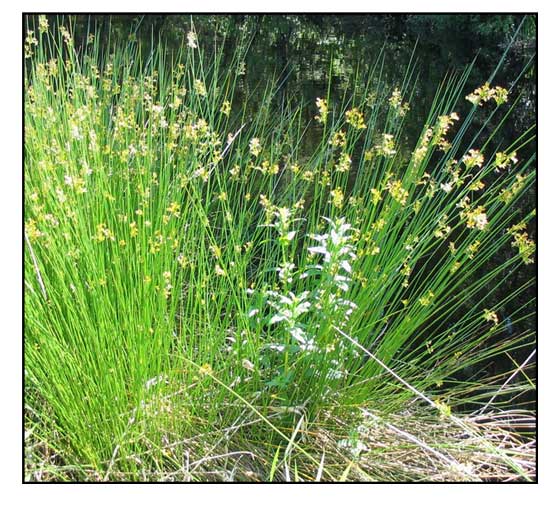 Uses Uses
Edibility
- Juncus effusus is one of seven ingredients of hui sup tea.
Folkloric
- Pith is used for keeping open fistulous sores.
- Malays used the pith for urinary troubles.
- Decoction used as antilithic, pectoral and descutient.
- In traditional Chinese medicine, used for painful urination, insomnia and sleep restlessness, sore throat, and ulcerations of the mouth and tongue. Used to eliminate excessive "heart-qi" and induce urination.
- Cherokees use the herb as an herbal constituent in emetic preparations; also, used as cathartic.
- In China and Japan, folk medicine for fever, insomnia, eclampsia, and fever sores.
- Charred juncus used as sedative.
- In Peninsular Malaysia, pith imported from China used as drug ('sumbu china') for urinary problems. The China and Vietnam, it is considered antilithic, pectoral, discutient, refrigerant, diuretic, depurative, and sedative; ussed to keep fistulous sores open. Root also considered diuretic. (30)
Others
• Crafts: Stem piths used for basketry, weaving mats, and for making lamp wicks. Dried stems used for making rope. Stems used for tying parcels. Pith made into lamp-wicks. (•) In Japan, this rush, igusa, is grown to be woven as covering to tatami mats. In Iran and Afghanistan, it is also used for weaving light cheap mats. In Europe, the rush was once used to make rushlights, the pith soaked in grease, as cheap alternative to candles. (26)
• Paper: Fiber from stems used for making paper.
• Habitat and fodder: The species provides wildfowl, wader feeding, and nesting habitats, and also habitats for small mammals. Rootstocks are eaten by muskrats, and birds take shelter amongst the stems. Number of invertebrates feed on soft rush, including rufous minor moth. (26) Readily eaten by goats but rarely by sheep. Reported to be poisonous to cattle. (30)
Studies
• Phenolic Contents: Ethanolic extract of the dry stem of J effusus yielded six phenolic constituents. Compounds 5 and 6, p-hydroxybenzaldehyde and luteolin-5-3'-dimethyl ester were reported for the first time. (2)
• Effusenone A / Phenolic Compounds: Study yielded a novel diterpene, effusenone A, and three novel phenolic compounds from the stem of J. effusus.
• Dihydrodibenzoxepin / Cytotoxicity: Study isolated a novel dihydrodibenzoxepin and preliminary brine shrimp lethality assay showed it to be cytotoxic. (3)
• Sedative / Hypnotic Effect: Study of extracts of JE showed influences on autonomic activity and sleeping time with pentobarbital sodium. The ethyl acetate extract showed to be the effective sedative and hypnotic fraction. (8)
• Dehydroeffusol / Anxiolytic / Sedative: Study isolated a novel phenanthrene chemical, dehydroeffusol, which showed anxiolytic and sedative properties. (9)
• Chemical Constituents / Antibacterial: Study isolated 30 compounds, six of which were new. Compound 6 (dehydroeffusol) showed antibacterial activity, with good inhibitory effect on four gram positive bacteria and Candida albicans. (12)
• Protective Effects from Cytotoxicity and Apoptosis / Root Bark: Study reports on two Chinese medical herbal extracts from roots barks of J. effusus and Paeonia suffruticosa that showed protective effect in NS-SV-Ac cells from cytotoxicity and apoptosis caused by CDDP (cis-platinum (II) diammine dichloride). Results explained the potency of the extracts as novel candidates for xerostomia in patients undergoing chemotherapy. (15)
• Anti-Inflammatory / Pith: Study evaluated the effects of ethanol extract from pith of J. effusus on anti-inflammatory activities of RAW 264.7 cells. Results showed anti-inflammatory activity by suppressing the production of inflammatory mediators in LPS-stimulated RAW 264.7 cells and by attenuating edema in mice. (16)
• Antibacterial: Study isolated thirty-one compound. Compound 6, dehydroeffusol, tested against nine bacterial strains, showed good inhibitory effect on four gram + bacteria and Candida albicans. (see constituents above) (17)
• Remediation of Contaminated Mines: Water draining from abandoned mines is often highly acidic and contaminated with toxic metals. Study evaluated the remediation capacity of natural wetlands in Wales, UK. Study showed plant life might be absorbing some of the toxic elements; concentrations of iron, zinc, and copper were found reduced. The three most common plants in the wetland were soft rush (Juncus effusus), common reed (P. australis) and common cottongrass (Eriophorum angustifolium). Of these, soft rush was found to absorb the highest level of the three metals. (18)
• Phenanthrenes / Anxiolytic and Sedative: Study of aerial parts isolated 8 phenanthrenes. Compounds 7 and 8 (effusol and juncusl, respectively) showed anxiolytic and sedative activities. (see constituents above) (20)
• Cytotoxic / Anti-Inflammatory: Study isolated a new sesquilignan effususin E (1) and a new long chain fatty enamide effususin F (2), along with eight known compounds from the medullae of Juncus effusus. The new compounds, effususin E and F, were evaluated against five human cancer cell lines (SHSY-5Y, SMMC-7721, HepG-1, Hela, and MCF-7. Only compound 1 exhibited weak cytotoxic activity against SMMC-7721. Compounds 1 and 2 showed good inhibitory activity against NO production in lipopoly-saccharide-induced RAW264.7 macrophages, with IC50 of 8.59 and 13.73 µm, respectively. (21)
• Anticancer / Antioxidant / Invention: Invention relates to a pharmaceutical composition having an antioxidant and anticancer effect with an extract of Juncus effusus as an active ingredient. In the invention the ethanol extract of J. effusus was fractionated and compound 1 and 2 (dehydroeffusol and effusol, respectively) were measure for antioxidant and anticancer effect. Both compounds showed more than 90% DPPH free radical and ABTS free radical scavenging activity. Both compounds showed similar or higher inhibitory effects on cancer cell growth (human gastric cancer cell line/AGS and lung cancer cell line/A549) than anticancer drug (CPA, cyclophosphamide). (22)
• Dihydrophenanthrenes / OAT Inhibitors / Medulla: Study evaluated the interactions of J. effusus phytochemicals with human OAT1 and OAT3. Bioactivity guided phytochemical investigation yielded seven new phenanthrenoids along with nine known compounds, including eight phenanthrenoids and a benzophenone from the dichlormethane soluble fraction of ME of medullae. Compounds 10 and 16 were inhibitors of OAT1, and compounds of 1-3, 10, and 16 were inhibitors of OAT3 with IC50 values less than 5.0 µM. Dihydrophenanthrene 1 altered the pharmacokinetic parameters of the diuretic drug furosemide, a known substrate of both OAT1-and OAT-3, in vivo. (23)
• Protection of Salivary Gland Acinar Cells from Apoptotic Cell Death Induced by Cis-Platinum Diammine Dichloride / Root Bark: Study reports on the protective effect of root barks of Juncus effusus ad Paeonia suffruticosa in NS-SV-Ac cells from cytotoxicity and apoptosis caused by CDDP. Effect was dependent on p53 pathway, protein kinase B7Akt1 and mitochondrial apoptosis related protein. Results suggest potential of the extracts as novel candidates for xerostomia and to improve quality of life of patients undergoing chemotherapy. (24)
• Estrogenic / Anti-Inflammatory Phenanthrenes: Study isolated one new phenanthrene, Junfusol B, along with 17 known compounds. Isolates were evaluated for estrogenic and anti-inflammatory activities considered relevant etiologic factors of insomnia, tinnitus, and edema in ancient TCM theory. The phenanthrenes were shown to exhibit estrogen-regulating potential. Phenanthrenes 3-7 exhibited significant inhibition on superoxide anion generation and elastase release in fMLP/CB-induced human neutrophili inflammation model. Results suggest potent for use in menopausal syndromes. (27)
• Anti-Inflammatory Against Periodontal Infection: Periodontitis is a chronic inflammatory disease caused by periodontopathogenic bacteria that form biofilms in periodontal pockets. Study evaluated the effect of a water extract of J. effusus on inhibition of the inflammatory reaction elicited by bacterial infection and protection of the oral epithelium by chemical irritation. Pretreatment of oral epithelial cells with JE extract significant reduced Porphyromonas gingivalis or its lipopolysaccharide (LPS-)-mediated production of chemokines (IL8 and C-C-chemokine ligand 20) in a concentration dependent manner with effects comparable to or greater than epigallocatechin gallate and protected oral epithelial cells from injury by chemical irritants, cetylpyridinium chloride and benzethonium chloride. Also, the JE extract in the presence of antimicrobial agents or fibrinolytics in mouthwash could significantly reduce chemokines from P. gingivalis LPS-stimulated oral epithelial cells in a concentration dependent manner. Results suggest potential for use in oral care to prevent periodontal infections and maintain oral epithelial function. (28)
• Enhanced Cognitive Function in the Elderly / Randomized Clinical Trial: On basis of evidence that dehydroeffusol prevents amyloid-ß-induced memory deficit and neurodegeneration in mice, study evaluated the effect of Juncus effusus extract powder enriched with dehydroeffusol on cognitive and dexterous performance of elderly people in a randomized, double-blind, placebo-controlled, parallel-group study of 41 participants. Tast scores were evaluated using the Five-Cog test 24 weeks after intake. Results suggest the intake of J. effusus extract powder may improve the cognitive function of elderly people. Task score was significantly higher for assembly task in the dexterity test, suggesting the extract powder may improve dexterous movement of elderly people. No adverse effects were observed. Results suggest extract powder enriched with dehydroeffusol may benefit cognitive and dexterous performance in the elderly. (29)
Availability
Wild-crafted.
Powders, pellets and extracts in the cybermarket.
|

![]()




 Botany
Botany Constituents
Constituents Properties
Properties
